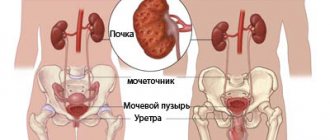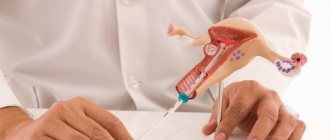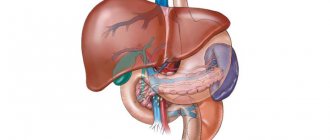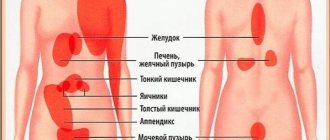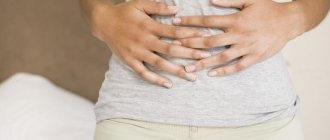October 31, 2021
In addition to the already mentioned pain in the lower abdomen, patients during menstruation are often bothered by other symptoms: emotional and mental disorders - irritability, drowsiness, insomnia, odor intolerance, etc.
Pain during menstruation (dysmenorrhea).
Every woman at least once in her life has encountered unpleasant and painful sensations during menstruation. For some, they occur occasionally with colds and weakened immunity, while others suffer from pain all their lives. In modern medicine, painful menstrual syndrome is regarded as a disease called “algomenorrhea” or “dysmenorrhea”. The first name is considered to be more accurate, but due to its length, the second name – dysmenorrhea – is more often used.
It is very difficult to understand on your own why your stomach hurts during menstruation, and the lack of proper treatment can lead to serious problems. Therefore, with this symptom, it is better to immediately contact a gynecologist at the clinic for qualified medical help.
In addition to the already mentioned pain in the lower abdomen, patients during menstruation are often bothered by other symptoms: emotional and mental disorders - irritability, drowsiness, insomnia, odor intolerance, etc. Manifestations of a “vegetative storm” - nausea, chills or a feeling of heat, sweating, dry mouth, bloating, frequent urination, etc. Vascular dysfunction - headache, dizziness, arrhythmias, numbness in the arms and legs, swelling of the face, etc.
Metabolic and endocrine disorders - weakness, itching, joint pain, swelling, feeling of “woolly” legs, etc. Menstrual pain is usually cramping, that is, it increases and decreases. It feels like you've overextended your muscles. Pain during menstruation should not be sharp, it is rather nagging. If you suddenly feel a sharp, cutting pain in the left lower abdomen, consult a doctor immediately. Most likely, the cause of this pain is not menstruation, but other health problems.
With primary dysmenorrhea, it is not possible to identify a reliable organic cause of pain during the examination. Usually the causes are: instability in the level of sex hormones and hormone-like substances, as well as disturbances in the functioning of the nervous system. Changes occur in the body that cause increased contractility of the muscles of the uterus (myometrium). The result is pain. In addition, against the background of malfunctions of the nervous system, sensitivity to pain increases.
Most often, primary dysmenorrhea occurs in young girls who have just begun to establish their menstrual cycle. When menstrual cramps are the result of another disorder, treatment for that disorder is provided if possible. For example, a narrow cervical canal can be widened surgically. However, this surgery usually only relieves pain temporarily. If necessary, fibroids or abnormally located endometriotic tissue (due to endometriosis) are removed surgically. When a doctor diagnoses primary dysmenorrhea, he or she reassures the woman that no other disorder is causing the pain and recommends general measures to relieve symptoms.
Symptoms of algodismenorrhea.
Pain during menstruation may occur only occasionally or regularly. In some cases, they are accompanied by other symptoms:
- metabolic-endocrine (hormonal imbalance, skin itching, swelling, vomiting, weakness, joint and muscle pain);
- vegetative (headaches, dizziness, dry mouth, nausea, hiccups, flatulence, frequent urination, cold extremities, fever or chills);
- emotional and mental (irritability, nervousness, tearfulness, depression, drowsiness or insomnia, loss of appetite or uncontrollable “eating”).
Classification.
There are 2 types of dysmenorrhea.
Functional or primary.
Typical for teenagers and 20-25 year old women, not associated with diseases. Appears on the first day of menstruation or the day before it. Lasts for 2-42 hours. The pain can be aching, cramping or bursting, and can radiate to the bladder or intestines.
Organic or recycled.
Most often diagnosed in women over 25 years of age. It is the result of gynecological or urological diseases. Pain syndrome appears 1-2 days before menstruation and lasts from 3 to 5 days. The woman experiences severe pain in the abdomen, perineum and lower back, and clots appear in the blood.
Painful periods - what to do?
Menstruation accompanies women throughout the reproductive period. For several days in each cycle, women experience some discomfort and malaise. Unfortunately, the severity of discomfort varies quite widely: from moderate tugging sensations in the lower abdomen to severe pain, forcing significant adjustments to the usual lifestyle.
Painful menstruation, of course, is far from the norm. Moreover, this condition is well studied and is reflected in the International Classification of Diseases as dysmenorrhea.
Dysmenorrhea can be primary or secondary. In order to understand what the patient is faced with, doctors begin a diagnostic search. If the cause could not be found, and menstruation became painful in youth, we need to think about the primary
, or
idiopathic dysmenorrhea
.
Secondary dysmenorrhea
- this is when pain during menstruation is a symptom of a disease: inflammation, cyst, endometriosis, abnormal development of the genital organs, etc. Treatment of secondary dysmenorrhea is the treatment of the disease for which menstrual pain is a symptom. For endometriosis, for example, long-term hormone therapy will be carried out. For abnormalities in the development of the genital organs, surgical treatment options will be considered.
Treatment of dysmenorrhea
Helping patients with primary dysmenorrhea is very simple - just choose the right NSAID (non-steroidal anti-inflammatory drug): indomethacin, ibuprofen, ketoprofen, celecoxib, etc. In most cases, one tablet is enough to completely relieve pain in the current cycle. For severe pain and regular menstruation, you can start taking NSAIDs 2-3 days before menstruation.
- What kind of treatment is this? They're just painkillers. - Not really. NSAIDs suppress the synthesis of prostaglandins, so they act not only symptomatically (simply relieve pain), but also pathogenetically (affect the mechanism of pain development in primary dysmenorrhea).
If you take NSAIDs in each cycle for primary dysmenorrhea, the severity of pain decreases from cycle to cycle.
It is very easy to help patients who are sexually active and not planning a pregnancy. The ideal way to get rid of menstrual pain would be COCs (combined oral contraceptives). It is not without reason that among the non-contraceptive advantages of COCs, the elimination of dysmenorrhea and other menstrual irregularities comes first.
Rarely, but still there are patients who do not respond well to NSAIDs and COCs. In this case, a combined method is used: COC + NSAIDs.
Treatment errors
Despite the obvious simplicity of the situation, there is a whole bunch of myths, misconceptions and nonsense surrounding painful menstruation.
Most patients with painful menstruation do not seek medical help, probably not considering such pain as a sign of illness. Mothers who suffered from dysmenorrhea in their youth boldly transfer their experience to their daughters: “It will go away when you give birth to a baby.” With moderately severe symptoms, our women prefer to “drink something” or lie down. Unfortunately, this “something” is most often no-shpa.
— I don’t understand why 80% of my patients take no-shpa for menstrual pain. - Well, they say on TV that no-spa helps. - Where do they say? Who's speaking? - Well, they are playing an advertisement where a bride is standing in a white dress, and her mother is giving her no-shpu. — Why do you think that the bride is menstruating???
No-shpu really accepts a huge number of women. Some were advised by their mother, others by a friend, others by a gynecologist. She doesn't help much. Actually, he has the right not to help at all, because menstrual pain is almost unrelated to spasm. Although in case of severe dysmenorrhea, no-spa may be recommended and appropriate as part of combination therapy.
The most curious thing is that the majority of patients who prefer “no-shpu and lie down”, as a rule, have had successful experience in taking NSAIDs, but continue to use not very effective drugs, fearing regular use of “too strong” or “too harmful” pills. NSAIDs, of course, have a damaging effect on the stomach wall with long-term regular use. Although application once every 24–30 days can be called regular, serious additional damaging factors are required for the formation of a peptic ulcer. If the patient already has a stomach disease, you can offer drugs containing celecoxib - they are most gentle on the gastrointestinal mucosa.
A special case
Sometimes we come across girls suffering from severe menstrual pain. Pain gradually turns an enthusiastic and carefree young lady into a person with rapidly declining self-esteem.
- What's wrong with you? Get your act together! Why can't you "cope" with your regular periods? - reproach peers. “We don’t understand what happened to her.” “She’s not the same carefree girl anymore,” the parents are perplexed. “Perhaps she just doesn’t want to go to school?”
Regular sanitary tampons can increase pain. Medicines help little or not at all. Girls skip school, refuse to go to the pool and participate in sports events, and it becomes increasingly difficult for them to maintain relationships with friends.
The pain can be so severe that you have to call an ambulance. Doctors rule out acute appendicitis, pregnancy and recommend screening for sexually transmitted diseases, ultrasound and computed tomography. Such an experience leaves an extremely negative aftertaste. For some young patients, such active intervention is not much different from physical violence. When even after all the above, no answers are received except that the girl does not have any of the above-mentioned conditions, she is advised to take some kind of painkiller.
But if:
- cyclical pain lasts more than 6 months;
- the patient is bothered by severe pain, and upon examination the doctor finds no (or almost no) signs of the disease;
- treatment helps poorly, hardly helps or does not help with a second course of therapy,
endometriosis and associated secondary dysmenorrhea can be suspected.
Unfortunately, in order to diagnose endometriosis in women, it is necessary to undergo a diagnostic laparoscopy.
Alas, not every representative of the fairer sex is ready to decide on surgery for diagnostic purposes. Just imagine how difficult it is to explain to the parents of a young girl that their daughter needs surgery to make sure that her menstrual pain is not related to endometriosis.
World Endometriosis Society expert Professor Robert Albee in his article calls on all humanity: “Please believe young women when they say they are in pain!”
The idea that the young woman is pretending, exaggerating her suffering, occurs not only to her relatives, but also to her attending physicians. This is a very dangerous misconception. There is nothing more offensive to a suffering person than the mistrust of people from whom he expects help.
Oksana Bogdashevskaya
Photo thinkstockphotos.com
Products by topic: [product](indomethacin), [product](ibuprofen), [product](ketoprofen), [product](celecoxib), [product](drotaverine), [product](no-spa)
Causes of painful menstruation.
The following factors can provoke functional pain:
- excess production of certain hormones (most often prostaglandins);
- reduced pain threshold;
- magnesium deficiency in the body;
- physical fatigue;
- hypothermia or overheating;
- frequent stress.
The causes of organic dysmenorrhea are:
- malformations of the uterus (underdevelopment, abnormal location);
- pathologies of the reproductive system that impede the movement of menstrual blood;
- inflammatory diseases of the genitourinary system;
- adenomyosis, endometriosis;
- varicose veins of the pelvic veins;
- adhesions in the fallopian tubes or in the pelvic area;
- myoma, fibromyoma;
- cysts and polyps of the ovaries and uterus;
- venereal diseases;
- intrauterine device;
- gynecological operations;
- C-section;
- frequent abortions;
- disruption of the functioning of the gastrointestinal tract.
The risk of algodismenorrhea increases with genetic predisposition, professional sports, heavy physical labor, excess weight, and absence of childbirth.
Medicines for menstrual pain
In case of more pronounced and severe pain and the absence of any pathology, it is worth connecting medicinal treatment, such as painkillers during menstruation, these can be: analgesics (eliminate pain from mild to moderate);
antispasmodics; nonsteroidal anti-inflammatory drugs (NSAIDs), which relieve moderate to severe pain); oral contraceptives (hormonal birth control pills that normalize the reproductive function of the female body).
Nonsteroidal drugs
They contain Ibuprofen and are suitable even for teenage girls. Such drugs fight inflammatory processes and relieve spasms. Within 30-40 minutes after administration, you can feel significant relief.
Oral contraceptives
Birth control pills contain hormones that suppress ovulation. No ovulation - no painful menstruation. Among other things, they will relieve you of the symptoms of PMS (premenstrual syndrome). But keep in mind that you need to select such pills individually and only your gynecologist can do this based on the results of examinations and tests. The same hormones can be obtained in other ways, not only in tablets. For example, these could be: injections; hormonal patches that are glued to the skin; implants that are implanted under the skin of the arm; intrauterine device with hormonal effect.
How to reduce pain during menstruation.
eliminate functional algodismenorrhea : balanced physical activity (yoga will be especially beneficial), adequate sleep, balanced nutrition, avoidance of alcoholic beverages and smoking.
During menstruation, it is recommended to introduce more greens, vegetables, fruits, fish, seafood into the diet, and exclude salty and spicy foods, smoked foods, tea, coffee, and carbonated drinks from the menu.
For organic dysmenorrhea, analgesics and antispasmodics can be used as first aid. But they only temporarily alleviate the condition, as they are unable to get rid of the existing problem.
Therefore, it is necessary to contact a gynecologist. The doctor will conduct a diagnosis, identify the cause of the pathology and select the optimal treatment. If necessary, the gynecologist will recommend consulting with an endocrinologist or neurologist.
Take care of your health and contact a qualified physician if you experience any symptoms.

